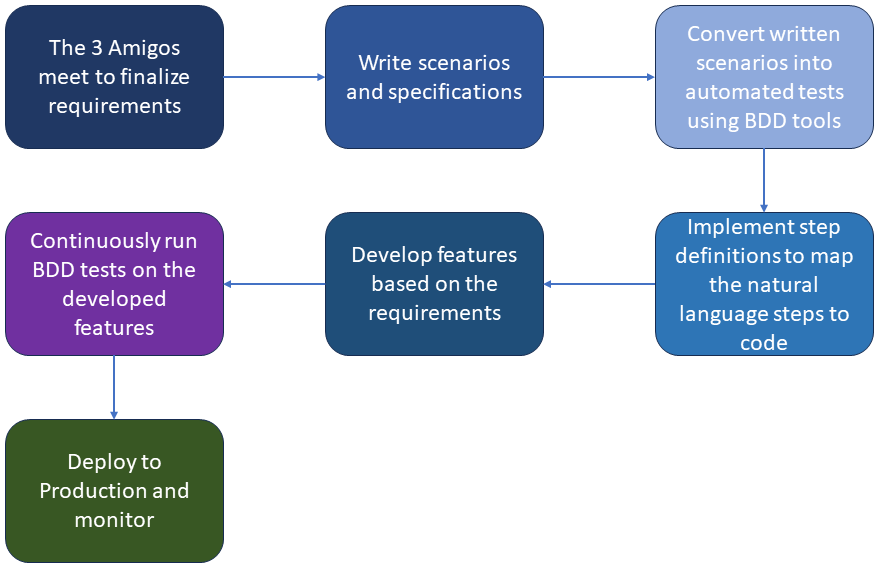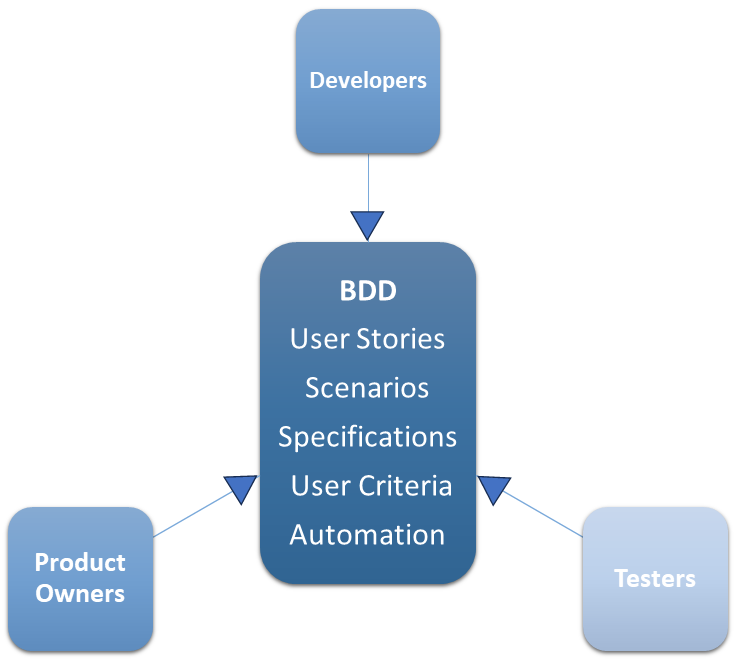What is a BDD Framework? The Complete Introduction
|
|
What is BDD?
Behavior-Driven Development (BDD) is a methodology emphasizing collaboration among developers, testers, and business stakeholders. BDD focuses on specifying the behavior of software through examples written in a shared language that everyone involved can understand.
By focusing on the behavior of the system, BDD helps teams develop software that genuinely meets customer needs and expectations.
In this post, we will understand BDD more deeply and how it is adopted into Agile.
How is BDD done?
BDD involves the 3 Amigos, that is, the developer, tester, and product owner, to collaborate and deliver high-quality products. Here’s a flowchart to give you an idea of the activities involved.

Read in depth about BDD methodology’s structure over here – What is Behavior Driven Development (BDD)? Everything You Should Know
How does BDD help the customer?
With BDD, the focus remains on the customer’s expectations out of the system or application. At the heart of it, BDD is meant to promote proactive communication between the stakeholders prior to shipping off the final result to the customer.
Hence, you can say that the key benefits of BDD for customers are:
- Clear communication and shared understanding
- Alignment of development with business goals
- Early issue identification
- Continuous feedback loop
- Better cost efficiency
- Reduced time to market
- Enhanced trust and collaboration
- Better user experience
How does BDD affect testers?
By now, we understand that BDD is a collaborative process. So the question arises as to how do testers come into the picture. Does anything change for them?
Testing was usually treated as a good-to-have activity in the older software development models. However, with modern software development ideologies, testing has been recognized as one of the key activities. In BDD, testers get a place at the table right from the start of the process. You tend to see the three amigos concept here – the product owner, developer, and tester interact to finalize the action plan on the requirements. It is crucial for all involved to not lose sight of the primary goals, meaning business requirements.

What a tester can bring to the table in BDD
As someone who understands the system and how to challenge it to reveal bugs, a tester has a lot to offer to the BDD process. Once the business problem is shared by the product owner, the tentative solutions are discussed. Even at this stage, a tester can add crucial insights into the plausibility of the solution. When defining the BDD scenarios, testers can use their experience to write the cases in plain English which everyone can understand. When designing these test cases, testers can highlight specific details that are missing and clarify them. Such fine combing of requirements through brainstorming helps develop a well thought out and (hopefully!) bug-free solution.
Does BDD affect testing strategies?
On the contrary, BDD helps get that precious alignment among the stakeholders right at the start of the cycle. Through the test cases that are written, new scenarios, as well as corrections to the prewritten scenarios can be incorporated. Once the scenarios are agreed upon, they can be automated or manually tested. In fact, once these scenarios are available, the task of testing based on these scenarios can be delegated to other testers who may not be familiar with the system. This can help save time and resource bandwidth of experienced testers.
What is a BDD framework?
You know that a framework is a set of tools that allow one to achieve a task. Thus BDD framework helps teams adopt the principles of BDD and implement them effectively in their software development process. It provides a structured approach to defining, executing, and maintaining automated acceptance tests. These tests are written in a plain language format which make them understandable to both technical and non-technical stakeholders.
The term “BDD framework” is more commonly used to refer to these tools as they are primarily used for testing purposes. However, the principles of BDD can be applied to the entire development process, including design, development, and testing.
Key Components of a BDD Framework
Most traditional BDD frameworks use the following components.
- Feature files: Written in plain language and structured around feature requirements. They describe the desired functionalities with example scenarios in Given-When-Then format.
- Step definitions: Link the plain language statements in feature files to code that executes the specified steps.
- Test runner: Runs the test scenarios by executing the step definitions for each scenario described in the feature files.
Automation and BDD
Usually, the test cases that are documented as a part of BDD are automated. The aim being that these same test cases should be able to validate the code and thus ascertain that the acceptance criteria set through the documented scenarios are met. This helps gauge how well all teams have understood and considered the customer’s point of view. With this information in hand, the automation and even the development code are refactored, and reusable functions are identified that can be reused across components.
A BDD test case example
Let’s look at an e-commerce website checkout use case. Here’s how BDD frameworks like Cucumber, SpecFlow, or JBehave will handle it.
Scenario: A user should be able to complete a purchase successfully.
Given:
A user is logged in to the e-commerce website.
The user has added items to their cart.
The user has provided their shipping address and payment details.
When:
The user clicks the “Checkout” button.
Then:
The order should be placed successfully.
The user should receive an order confirmation email.
The order status should be updated to “Processing”.
The items should be removed from the user’s cart.
@Given("a user is logged in to the e-commerce website")
public void user_is_logged_in_to_the_e_commerce_website() {
// Login to the website as a registered user
loginPage.login("[email protected]", "password123");
}
@And("the user has added items to their cart")
public void the_user_has_added_items_to_their_cart() {
// Add items to the cart
homePage.searchForProduct("Laptop");
homePage.addProductToCart();
}
@And("the user has provided their shipping address and payment details")
public void the_user_has_provided_their_shipping_address_and_payment_details() {
// Fill in shipping address and payment details
checkoutPage.fillShippingAddress("Test User", "123 Main St", "City", "State", "12345");
checkoutPage.fillPaymentDetails("Card Number", "Expiry Date", "CVV");
}
@When("the user clicks the \"Checkout\" button")
public void the_user_clicks_the_Checkout_button() {
// Click the Checkout button
checkoutPage.clickCheckoutButton();
}
@Then("the order should be placed successfully")
public void the_order_should_be_placed_successfully() {
// Verify order confirmation message
orderConfirmationPage.verifyOrderConfirmationMessage();
}
@And("the user should receive an order confirmation email")
public void the_user_should_receive_an_order_confirmation_email() {
// Check email inbox for confirmation email
// (This might involve mocking or integration with an email service)
}
@And("the order status should be updated to \"Processing\"")
public void the_order_status_should_be_updated_to_Processing() {
// Check order status in the order history
orderHistoryPage.verifyOrderStatus("Processing");
}
@And("the items should be removed from the user's cart")
public void the_items_should_be_removed_from_the_user_s_cart() {
// Verify that the cart is empty
cartPage.verifyCartIsEmpty();
}
Most of these frameworks make use of the Selenium WebDriver to interact with the web application.
Optimizing BDD with AI-based tools
In the above sections we saw that the BDD cases are documented mostly using the Gherkin language, that is, the Given-When-Then syntax. This approach however has been observed to be taxing for the parties involved since phrasing and accommodating complex scenarios in this format can be challenging for all parties involved. Moreover, it is important to note that just writing these scenarios does not mark the BDD process as complete. With most BDD tools, you need to explicitly write code that will be associated with each of the Gherkin statements. Now, this requires special skills and not every tester can do this.
This is where testRigor helps.
testRigor for BDD testing
With tools like testRigor that make use of generative AI, you can implement the BDD philosophy easily. This tool is known for its rich feature set, near-null test maintenance efforts, unparalleled test execution stability, and simple user interface.
Here’s why testRigor is a better alternative to existing BDD frameworks.
No step definition process or feature file
This tool takes BDD a step further by allowing you to specify the steps in plain English language. The rest is taken care of by testRigor’s AI-powered engine, which interprets and executes the command.
Easy testing of complex use cases
Furthermore, it also has features like email, SMS testing, cross-browser and cross-platform testing, API testing, etc., to name a few. It also gives the capability to generate test data based on regex.
Unparalleled stability of tests
The test runs executed using this tool are so stable that they are even used to monitor the health of the product.
Negligible test maintenance costs
A running narrative associated with test automation is the massive test maintenance efforts. Imagine the efforts in maintaining the step definition file and the step execution file as the application grows? All this hassle is slashed down since testRigor only asks you to write what it should do in plain English – specification-driven development(SDD).
Conclusion
BDD is indeed a good process to have since it will help you ensure customer satisfaction and save a lot of time and effort by forcing the stakeholders to align on the system’s behavior before jumping into development. Couple it with the right set of tools and you will be operating efficiently and producing high-quality products.
| Achieve More Than 90% Test Automation | |
| Step by Step Walkthroughs and Help | |
| 14 Day Free Trial, Cancel Anytime |












